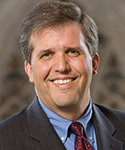Everyone praises the quarterback of a football team. The acknowledged leader of the offense and a key architect of a team’s identity, even casual football fans know the names of great quarterbacks: Unitas, Montana, Elway, Favre, Brady, Manning, McNabb. It is no surprise that quarterbacks have the highest average pay among position players in the NFL.
Virtually nobody suspects that the second-highest average pay in the NFL belongs to left tackles. Who are they? They are anonymous to many, but quarterbacks, opposing linebackers, coaches and general managers know them. In the 2009 NFL draft, three left tackles were taken in the first eight picks; only two quarterbacks were taken in that same span. Most quarterbacks are right-handed, so left tackles are crucial. They protect the quarterback’s blind side.
We tend to give little attention to the “left tackles” of Christian institutions. We know about the importance of the key leader, the president/dean/CEO, the person who is the public face of the organization. We often refer to such leaders as “quarterbacks,” and expect them to call the plays or improvise when the plays break down. Our left tackles have titles such as CFO, the person whose financial knowledge is critical to anticipating the ups and downs of investments, budgets and cost-drivers. The left tackle may be the COO, a deputy who works quietly behind the scenes to manage the organization effectively and strategically. In other organizations, the left tackle may be a savvy academic dean who provides intellectual oversight or a clergy member who leads a particular geographic or program area within a judicatory.
What is the cost of ignoring the left tackles? In his recent book, “The Blind Side: Evolution of a Game,” Michael Lewis tells the story of the Monday Night Football game in November 1985 when Lawrence Taylor of the New York Giants came from the blind side and caught Redskins quarterback Joe Theismann completely unawares. As millions of Americans watched in horror, and then in horrifying replay after replay, the tibia and fibula in Theismann’s right leg snapped beneath him.
Theismann’s career ended that night. And the desire to find very big, very strong, very quick, talented left tackles became a high priority for NFL owners, coaches and general managers. Even though left tackles were important before that night, their indispensable role in protecting the quarterback, and enhancing the team’s chances of success, became clear when the Redskins no longer could turn to their star quarterback.
Left tackles remain nameless, despite their importance, because they play an unglamorous position. Everybody remembers the quarterback’s great throw, or the running back’s touchdown run, but the commentators rarely show a replay of a left tackle’s key block. Yet great left tackles have been known to enable average quarterbacks to be quite successful, even as great quarterbacks have been weakened -- or their careers ended -- by failures to protect their blind side.
We haven’t yet learned that lesson in our Christian institutions. This spring I was struck by the judgment of an executive coach we had hired to work with a judicatory leader. This coach typically works with business executives, and he said this judicatory leader is as gifted and skilled a leader as any of the business executives with whom he has worked. But, the coach added, there was a significant gap between the judicatory leader’s gifts and the next tier of people with whom the leader worked.
Is it any wonder that the judicatory is struggling as an institution, and that the judicatory leader is frustrated? Even charismatic leaders with superb management skills will have limited success if they have mediocre or weak people in their senior leadership team.
The economic downturn has forced us to look closely at the roles of all of our executives. In this environment, our institutions are fragile and we need strategic responses that exceed the ability of any single “quarterback” president or CEO to improvise or call an audible. We need to pay more attention to all of the key leadership positions in an organization, including those that are less glamorous but indispensable to enabling healthy organizational cultures and gifted institutional leaders to succeed.
This will include paying more attention to the job descriptions for those positions and seeking people to fill them who might not otherwise apply. Perhaps a key Christian institutional leader will be found among those who have served in business -- or as a managing partner of a law firm -- and are now looking for a shift in their vocation.
We need to develop stronger strategies for equipping the leadership teams as a whole, and not only the CEOs. Too often CEOs have great, formative leadership development experiences, but the gap remains between their skills and those elsewhere in their leadership team. If we can equip all team members to serve in their jobs more effectively, then the entire organization flourishes. Leadership at its best develops the gifts and skills of the entire team, not just those in the most visible positions.
We can’t afford to neglect paying attention to our left tackles, identifying people with the gifts needed, mentoring and developing them over time, honoring them for the key roles they play…and paying them well.














